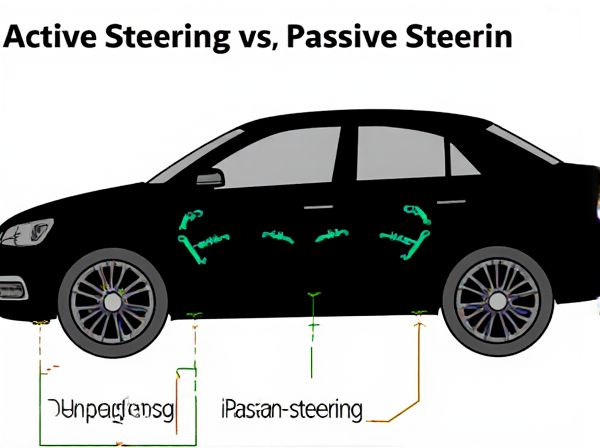
Photo illustration: Active Steering vs Passive Steering
Active steering systems dynamically adjust the vehicle's wheel angles based on driving conditions, improving handling, stability, and response times. Passive steering relies on the mechanical design of the suspension and steering components, offering a fixed steering ratio without adaptive adjustments. Your choice between active and passive steering influences driving precision and comfort, especially during high-speed maneuvers or uneven road surfaces.
Table of Comparison
| Feature | Active Steering | Passive Steering |
|---|---|---|
| Definition | Steering system with electronic control for dynamic adjustment | Conventional mechanical steering without electronic adjustment |
| Control Mechanism | Electronically actuated steering angle changes | Direct mechanical linkage between steering wheel and wheels |
| Steering Precision | High precision with adaptive response to driving conditions | Limited precision, depends on mechanical parts |
| Driving Comfort | Enhanced comfort via reduced steering effort and vibration absorption | Standard steering effort, less vibration dampening |
| Safety Features | Integrated with stability control and collision avoidance systems | Basic safety dependent on mechanical reliability |
| Maintenance | Requires electronic system diagnostics and specialized servicing | Simpler maintenance with mechanical inspections |
| Cost | Higher initial and repair costs due to complexity | Lower cost with simpler construction |
| Fuel Efficiency Impact | Potential improvement by optimizing steering input | Neutral effect on fuel consumption |
Introduction to Steering Systems
Active steering systems dynamically adjust the steering angle based on driving conditions using electronic control units and sensors to enhance vehicle stability and handling. Passive steering relies on fixed mechanical linkages and geometry, with no electronic intervention, resulting in a direct but less adaptive steering response. Advanced active steering improves maneuverability and safety by optimizing steering inputs at various speeds compared to traditional passive steering systems.
What is Active Steering?
Active steering is an advanced automotive technology that dynamically adjusts the steering angle based on input from sensors and driving conditions, enhancing vehicle stability and maneuverability. Unlike passive steering systems, which rely on fixed mechanical linkages, active steering uses electric motors and electronic controls to modify steering response in real-time. This technology improves handling precision, reduces steering effort at low speeds, and increases safety during high-speed driving or emergency maneuvers.
What is Passive Steering?
Passive steering refers to a vehicle suspension system design that does not actively control wheel angles or steering inputs but relies on mechanical linkages and the natural movement of suspension components to influence wheel direction. Unlike active steering systems that use electronic sensors and actuators to adjust the steering angle dynamically, passive steering systems maintain a fixed geometry determined by their physical setup. This approach offers reduced complexity and cost but may sacrifice some precision and adaptability in handling and maneuverability.
Key Differences Between Active and Passive Steering
Active steering systems use electronic controls and sensors to adjust the steering angle dynamically, improving vehicle handling and stability during various driving conditions. Passive steering relies on a fixed mechanical linkage without real-time adjustments, resulting in simpler design but less adaptive response to steering inputs. Key differences include responsiveness, complexity, and cost, with active steering offering enhanced precision and adaptability compared to the more traditional and cost-effective passive steering setups.
Advantages of Active Steering
Active steering enhances vehicle handling by dynamically adjusting the steering angle based on speed and driving conditions, offering improved stability and precision. This technology reduces understeer and oversteer, leading to safer cornering and better maneuverability in tight spaces. Compared to passive steering, active systems provide superior responsiveness and adaptability, increasing overall driving comfort and control.
Benefits of Passive Steering
Passive steering systems offer enhanced reliability and lower maintenance costs compared to active steering due to their simpler mechanical design. They provide consistent handling performance without the need for electronic control units or sensors, reducing the risk of failure in harsh driving conditions. This makes passive steering ideal for vehicles operating in environments where durability and dependability are critical.
Common Applications for Each Steering Type
Active steering systems are commonly applied in high-performance vehicles and luxury cars to enhance handling precision and driving comfort by dynamically adjusting the steering angle based on speed and road conditions. Passive steering, often found in motorcycles, bicycles, and basic automotive designs, relies on mechanical linkages without electronic control, making it ideal for simpler, cost-effective applications with predictable steering responses. Agricultural machinery and off-road vehicles sometimes use passive steering due to its durability and straightforward maintenance requirements under harsh conditions.
Performance Comparison: Handling and Safety
Active steering systems enhance vehicle handling by dynamically adjusting the front wheels' angle based on speed and driving conditions, resulting in improved cornering stability and reduced understeer compared to passive steering. Passive steering relies on fixed steering geometry, which can limit precision and responsiveness, especially at high speeds or during sudden maneuvers. The enhanced responsiveness and adaptability of active steering contribute to superior safety by providing better control and reducing the risk of loss of traction.
Maintenance and Reliability Considerations
Active steering systems require regular diagnostic checks and software updates to maintain optimal performance, as their complexity includes electronic components and sensors prone to wear or failure. Passive steering mechanisms generally have lower maintenance costs due to simpler mechanical parts but may experience increased wear on steering linkages and bushings over time. Reliability in active steering depends on robust electronic calibration and fault detection, whereas passive steering relies on mechanical integrity and regular lubrication.
Choosing the Right Steering System for Your Needs
Active steering systems use sensors and electronic controls to adjust the steering angle dynamically, providing improved handling, safety, and responsiveness in various driving conditions. Passive steering relies on fixed mechanical linkages, offering simplicity and lower cost but less adaptability to different driving environments. Choosing the right steering system depends on vehicle type, driving style, and budget, with active steering favored for performance and safety, while passive steering suits basic, cost-effective transportation needs.
 caratoz.com
caratoz.com